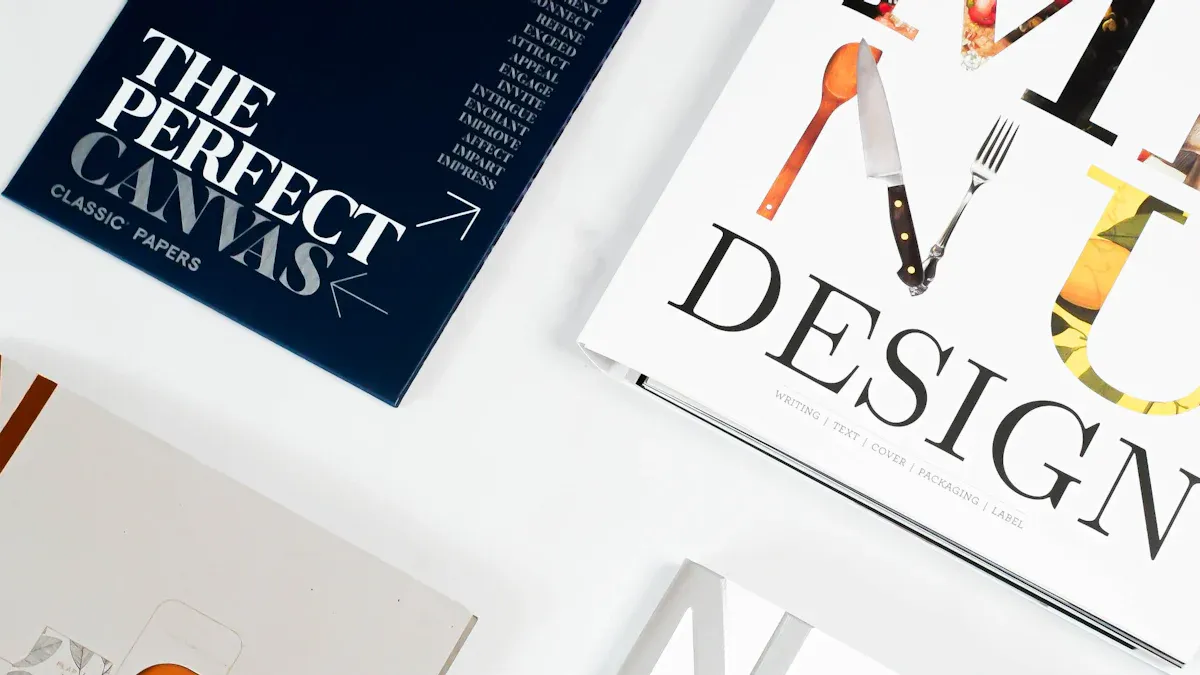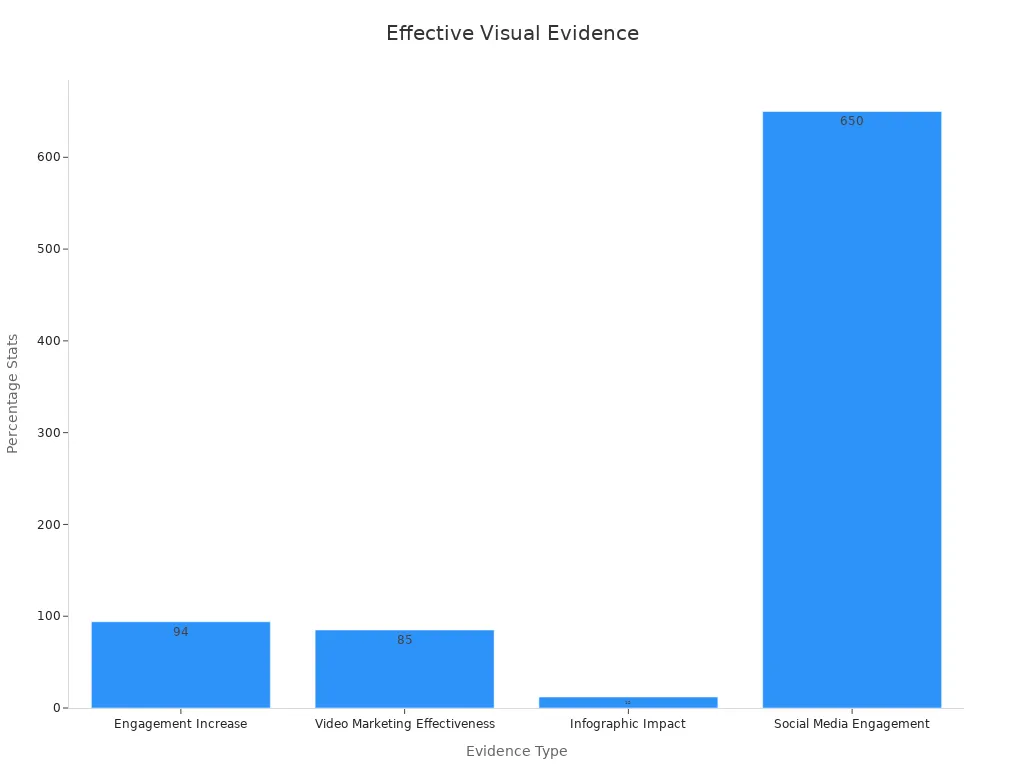Why Visual Communication Matters for Modern Brands

Visual communication holds the key to capturing attention in today’s fast-paced digital world. People remember 650% more of what they see compared to what they read, making visuals an essential tool for brands. Vibrant images in customer testimonials boost emotional impact by 102%, while product videos increase purchase likelihood by 85%. These statistics show why brands need to prioritize visual content to stay relevant and connect with audiences effectively. Visual Communication for Modern Brands ensures stronger engagement, leaving lasting impressions that drive results.
Key Takeaways
Pictures and videos grab attention more than words. Use them to make your brand easy to remember.
Matching visuals build trust. Follow simple rules to keep your visuals the same everywhere.
Visual tools help teams work better. Use apps like Canva and Figma to work together and decide faster.
Checking your visuals often keeps your brand consistent. Make sure your content always shows your brand’s style.
Fun visuals get people involved. Use charts and videos to explain hard ideas and get people interested.
The Challenges of Visual Communication for Modern Brands
Modern brands face unique challenges when it comes to visual communication. As digital platforms multiply, maintaining consistency and clarity in visual messaging becomes increasingly difficult. These challenges can impact your brand’s ability to connect with audiences and uphold a strong identity.
Managing Diverse Platforms and Channels
Navigating the complexities of diverse platforms is one of the biggest hurdles in visual communication. Each platform has its own rules, audience preferences, and visual styles. For example, social media platforms like Instagram emphasize vibrant imagery, while LinkedIn favors professional visuals. Adapting your content to fit these varying demands requires strategic planning and tailored approaches.
Quantitative studies highlight the difficulties brands encounter in managing visual communication across channels. Integrated Marketing Communications (IMC) stresses the importance of delivering a consistent brand message across all platforms. However, achieving this consistency demands alignment between internal and external communications. Tracking the effectiveness of IMC through customer responses and behavioral changes adds another layer of complexity. Without proper tools and strategies, you risk losing coherence in your messaging.
Images on social media are harder to analyze than text-based elements like hashtags, complicating cross-platform comparisons.
Visual features such as color warmth, brightness, and complexity vary across platforms, requiring tailored strategies for engagement.
Computational visual analysis can help brands understand platform-specific patterns and optimize their visual content.
Risks of Fragmented Brand Identity
Fragmented visual communication can weaken your brand identity. When visuals lack consistency, audiences struggle to recognize and trust your brand. This issue is particularly pronounced for large organizations with multiple locations or teams. A lack of unified messaging leads to inconsistencies in visual identity and client interactions, eroding trust and damaging your brand’s reputation.
Maintaining a cohesive visual identity is essential for building strong connections with your audience. If your visuals differ across campaigns or platforms, your brand may appear disjointed. This inconsistency can confuse your audience and reduce the emotional impact of your messaging. To avoid this, you need clear guidelines and tools that ensure alignment across all visual elements.
Limitations of Traditional Text-Based Tools
Traditional text-based tools fall short when addressing modern visual communication needs. While text can convey information, it often fails to capture the emotions and subtleties that visuals provide. For example, a product description may explain features, but a video showcasing the product in action creates a stronger emotional connection.
However, relying solely on visuals can also present challenges. Excessive use of visual elements may overwhelm your audience, making it harder for them to focus on your message. Additionally, visuals alone may oversimplify complex ideas, leading to a loss of critical details. Balancing text and visuals is key to effective communication.
Text-based tools struggle to convey the full essence of an idea, while visuals excel at capturing emotions.
Overuse of visuals can lead to distraction and information overload.
Simplifying complex information with visuals risks omitting important details.
By understanding these challenges, you can take proactive steps to overcome them. Leveraging the right tools and strategies will help you maintain consistency, strengthen your brand identity, and create impactful visual communication for modern brands.
Why Visual Communication Tools Are Essential

Aligning Creative Decisions with Brand Identity
Visual communication tools help you align creative decisions with your brand identity. They ensure that every visual element, from logos to advertisements, reflects your brand's core values. Research on political branding highlights the importance of a visual identity system. It shows that combining this system with a strategic communication plan maximizes influence and builds connections. For brands, this means using visuals to define your unique identity and communicate it effectively to your audience.
Visuals also play a critical role in capturing attention and evoking emotions. Studies show that logos, packaging, and advertisements anchor a brand's identity. They make your brand more memorable and impactful. By using visual communication tools, you can create cohesive designs that resonate with your audience and strengthen your brand's presence.
Enhancing Collaboration Among Teams
Visual communication platforms improve teamwork by fostering better collaboration. These tools allow your team to share ideas visually, making discussions more engaging and productive. Metrics like team response cohesion and collaborative decision speed show how these platforms enhance communication. For example:
Metric | Description |
|---|---|
Team Response Cohesion | Measures how consistently team members participate in group discussions and information sharing. |
Collaborative Decision Speed | Measures how quickly teams reach decisions through digital communication channels. |
Inclusive Communication Score | Tracks whether communication patterns include all team members or concentrate among a few individuals. |
By using these tools, your team can break down silos and work together more effectively. This leads to faster decision-making and better outcomes.
Streamlining Campaign Execution Across Channels
Visual communication tools streamline campaign execution by simplifying workflows. Teams using these tools complete tasks 50% faster and make 25% fewer mistakes. They also improve decision-making speed by 36%. Visuals help your team retain information better, with an 80% retention rate compared to 20% for text. These tools ensure that your campaigns stay consistent across platforms, saving time and reducing errors.
By adopting visual communication tools, you can optimize your campaigns and maintain a strong brand identity. This makes Visual Communication for Modern Brands a vital strategy for success.
Strategies for Maintaining Consistency Across Channels
Maintaining consistency across channels is essential for building a strong and recognizable brand. When your visuals align seamlessly, your audience can easily identify and trust your brand, no matter where they encounter it. Here are three strategies to help you achieve this consistency.
Establishing Clear Brand Guidelines
Clear brand guidelines act as a roadmap for your visual communication. They define how your brand should look and feel across all platforms. These guidelines typically include rules for logo usage, color schemes, typography, and imagery. By following these rules, you ensure that every piece of content reflects your brand identity.
Research shows that consistent communication significantly impacts brand trust and loyalty. For example:
Key Findings | Description |
|---|---|
Impact on Brand Trust | Communication consistency has a strong direct impact on brand trust. |
Impact on Brand Loyalty | Communication consistency significantly influences brand loyalty. |
Influence on Commitment | Positive influence on affective brand commitment, though not statistically significant. |
When you establish clear guidelines, you reduce the risk of fragmented visuals. This helps your audience recognize your brand instantly, whether they see it on social media, a website, or a billboard.
Leveraging Visual Communication Platforms
Visual communication platforms simplify the process of maintaining consistency. These tools allow you to create, store, and share visual assets in one centralized location. They also enable your team to collaborate effectively, ensuring that everyone stays aligned with your brand's visual identity.
Design professionals emphasize the importance of aesthetic unity in brand coherence. They focus on integrating color schemes, typography, and imagery to create a unified look. Consumer behavior analysts also highlight the benefits of coherence. Surveys reveal that 80% of customers feel more confident purchasing from brands with consistent visuals. Companies like Apple, Starbucks, and Nike demonstrate how leveraging these platforms enhances brand recognition and trust.
Using these tools, you can streamline workflows and ensure that every campaign reflects your brand's core values. This makes visual communication platforms an invaluable resource for modern brands.
Conducting Regular Audits for Brand Alignment
Regular audits help you identify inconsistencies in your visual communication. By reviewing your content across all channels, you can spot areas where your visuals may deviate from your brand guidelines. This process ensures that your messaging remains cohesive and impactful.
Consider how leading brands maintain alignment through consistent visual elements:
Brand | Key Visual Elements | Impact on Brand Identity |
|---|---|---|
Coca-Cola | Iconic logo, red and white color scheme, unique typography | Strong brand recognition and loyalty over a century due to consistent design. |
Apple | Minimalist design, clean lines, white space, sleek imagery | Reinforces brand image of innovation and quality, enhancing product appeal. |
Nike | Swoosh logo, bold typography, distinctive color palette | Conveys brand message of athleticism and excellence, contributing to global recognition. |
By conducting audits, you can ensure that your visuals remain consistent and aligned with your brand identity. This practice not only strengthens your brand but also builds trust with your audience.
Training Teams on Visual Collaboration Best Practices
Training your team on visual collaboration best practices ensures everyone works cohesively toward a unified brand vision. When your team understands how to use visual tools effectively, they can create consistent, impactful content that resonates with your audience. Here are some actionable steps to help you train your team for success.
1. Start with a Clear Vision
Before diving into tools and techniques, define your brand’s visual identity. Share this vision with your team so they understand the "why" behind your visual strategy. A clear vision acts as a compass, guiding every creative decision.
Tip: Use a visual mood board to illustrate your brand’s style, including colors, typography, and imagery. This helps your team visualize the brand identity in action.
2. Provide Hands-On Training with Tools
Equip your team with the right visual communication platforms and ensure they know how to use them effectively. Hands-on training sessions allow team members to explore features, ask questions, and practice in real-time.
Key tools to consider:
Canva for design simplicity
Figma for collaborative prototyping
Trello or Asana for visual project management
Note: Encourage your team to experiment with these tools during training. Familiarity builds confidence and reduces hesitation when using them for actual projects.
3. Foster a Culture of Feedback
Feedback is essential for improving visual collaboration. Create an environment where team members feel comfortable sharing ideas and constructive criticism. Use visual examples during feedback sessions to clarify points and inspire creativity.
Best practices for feedback:
Be specific about what works and what doesn’t.
Use visuals to demonstrate suggested changes.
Encourage open dialogue to refine ideas collaboratively.
4. Conduct Regular Workshops
Workshops keep your team updated on the latest trends and techniques in visual communication. Invite industry experts or use online resources to provide fresh perspectives. These sessions also serve as team-building opportunities, fostering collaboration and creativity.
Example Workshop Topics:
How to create platform-specific visuals (e.g., Instagram vs. LinkedIn)
The psychology of color in branding
Storytelling through visuals
5. Create a Visual Collaboration Playbook
Document your team’s visual collaboration processes in a playbook. This resource should include guidelines, tool instructions, and examples of successful campaigns. A playbook ensures consistency and serves as a reference for new team members.
Section in Playbook | Purpose |
|---|---|
Brand Guidelines | Defines visual identity elements like logos, colors, and typography. |
Tool Tutorials | Provides step-by-step instructions for using visual collaboration tools. |
Case Studies | Highlights successful campaigns to inspire future projects. |
6. Celebrate Successes
Recognize and celebrate your team’s achievements in visual collaboration. Highlighting successful projects boosts morale and reinforces the importance of teamwork. Share these successes during team meetings or through internal newsletters.
Emoji Tip: Use 🎉 or 👏 in team chats to celebrate milestones and foster a positive atmosphere.
By training your team on these best practices, you empower them to collaborate effectively and produce visuals that align with your brand’s identity. This investment in training not only enhances your team’s skills but also strengthens your brand’s presence across all channels.
Benefits of Visual Communication for Modern Brands

Improved Audience Engagement
Visual communication creates a more engaging experience for your audience. Interactive visuals, such as videos or infographics, encourage participation and leave a lasting impression. They simplify complex ideas, making them easier to understand and remember. For example:
Interactive experiences boost engagement rates by creating memorable moments.
Immersive visuals help audiences grasp complicated information quickly.
Emotional connections form when visuals evoke feelings, strengthening your bond with viewers.
Metrics like click-through rates and social shares highlight the effectiveness of visual content. Studies show that landing pages with videos can increase conversion rates by up to 86%. By using targeted visual strategies, you can captivate your audience and inspire action.
Stronger Brand Recognition
Consistent visuals make your brand instantly recognizable. When your logo, colors, and imagery align across platforms, your audience builds trust and familiarity with your brand. Research supports this:
Evidence Type | Statistic/Insight |
|---|---|
Engagement Increase | Posts with images receive 94% more views than those without. |
Video Marketing Effectiveness | 85% of businesses report video as an effective tool for enhancing brand recall. |
Infographic Impact | Infographics can increase website traffic by up to 12%. |
Social Media Engagement | Visuals generate 650% higher engagement than text-only posts. |

Case studies also reveal that consistent branding leads to revenue growth. For instance, 35% of organizations reported a 10-20% increase in revenue due to consistent brand presentation. By maintaining a cohesive visual identity, you reinforce your brand’s core values and improve audience recall.
Increased Efficiency in Campaign Management
Visual communication enhances campaign management by streamlining workflows and improving collaboration. Teams using visual tools complete tasks faster and with fewer errors. Visuals also make products more appealing, increasing the likelihood of purchase. Key benefits include:
Captivating visuals tell a compelling story.
Emotional connections with audiences drive engagement.
Clear messaging improves understanding and retention.
Additionally, visuals reduce marketing costs by delivering impactful messages efficiently. Infographics, for example, can increase website traffic by up to 12%, while videos enhance brand recall. By leveraging visuals, you can optimize your campaigns and achieve better results with fewer resources.
Visual communication drives modern branding success by connecting with audiences and creating a unified identity. Your brain processes images 60,000 times faster than text, and 90% of the information it receives is visual. Consistent branding across platforms can increase revenue by 23%, highlighting the importance of cohesive visuals.
Visual communication tools simplify creative processes for brand managers. They automate workflows, enhance collaboration, and ensure brand consistency across channels. These tools reduce confusion and bottlenecks, enabling faster creation of high-quality assets.
By adopting strategies like clear brand guidelines and leveraging visual-first tools, you can maintain consistency and streamline campaigns. Visual Communication for Modern Brands empowers you to overcome challenges and achieve long-term success.
FAQ
What is visual communication, and why is it important for brands?
Visual communication uses images, videos, and graphics to convey messages. It’s important because visuals grab attention faster than text. They help you connect emotionally with your audience and make your brand memorable.
How can visual communication tools improve teamwork?
These tools simplify collaboration by letting teams share ideas visually. They speed up decision-making and ensure everyone stays aligned with your brand’s identity. Platforms like Figma and Canva make teamwork more efficient.
What are brand guidelines, and how do they help?
Brand guidelines define your visual identity, including logos, colors, and typography. They ensure consistency across platforms, making your brand recognizable. Clear guidelines reduce confusion and strengthen trust with your audience.
How do visuals impact audience engagement?
Visuals make content more engaging by simplifying complex ideas and evoking emotions. Videos, infographics, and interactive designs encourage participation. Studies show visuals increase click-through rates and social shares significantly.
Can visual communication tools save time during campaigns?
Yes, these tools streamline workflows and reduce errors. They help teams create consistent visuals faster, improving efficiency. By using platforms like Trello or Asana, you can manage campaigns effectively and save valuable time.
See Also
Developing Your Brand's Visual Strategy Using Brands.Menu
Top Tools for Effective Brand Marketing Strategies
Unlock Your Brand's Full Potential Using These Tools


